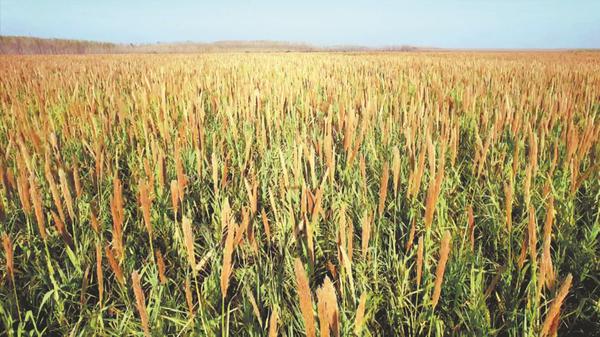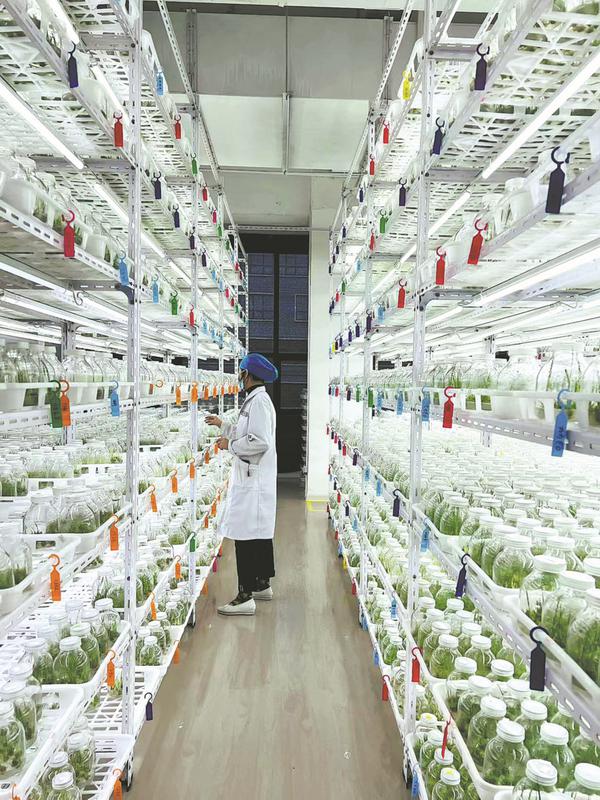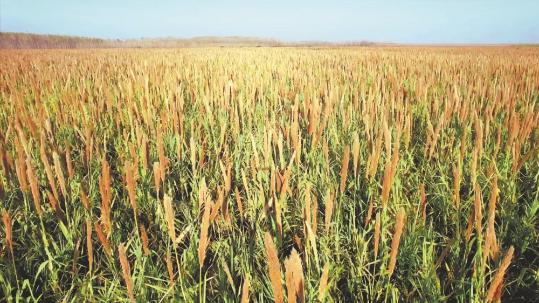'Super giant reed' biomass could replace fossil fuels for power generation

"Super giant reed" is planted in an experimental field. (Provided to CHINA DAILY)
After genetic transformation, "super giant reed", a bamboo-like grass, has become a high-yield renewable resource, according to a Chinese biotech company.
This "super giant reed", an improved version of the giant reed, includes more than 40 varieties developed using a gene database tailored for specific applications such as biofuels.
According to Landuo Biotech based in Wuhan, Hubei province, the biomass of super giant reed — an indicator of its potential as a fuel source — surpasses that of wild giant reed three times over.
These new varieties have a calorific value of 4,000 to 4,500 kilocalories per kilogram, or two-thirds of that of standard coal, making them a potential substitute for fossil fuels. Planting some 13,000 hectares of super giant reed is equivalent to creating a green coal mine with an annual output of 0.45 to 1.5 million metric tons, the company said.
"Super giant reed can replace coal in power generation, chemicals, construction materials and civil heating," said Song Xin, Landuo Biotech's general manager. "This will not only reduce fuel and material costs for enterprises but also help lower carbon dioxide emissions."
According to some estimates, planting 40 million hectares of super giant reed could replace 2.2 billion tons of coal used in power generation in China, cutting carbon dioxide emissions by 4 billion tons. The green power industry could generate an annual revenue of 250 million yuan ($34 million).
However, Song noted that replacing coal for power generation is just one of the low-value uses of super giant reed. "The real potential of transforming the fossil fuel industry lies in the high-value bio-based energy and chemicals produced from the reed."
Super giant reed is being developed for a wide range of applications, including bio-based power generation, oil refining, chemicals, biodegradable plastics and the fiber industry.
The company has also pioneered a processing technology for super giant reed. By isolating the plants in an oxygen-free environment, high-temperature pyrolysis can convert them into hydrogen, carbon monoxide, methane, natural gas, biochar and other products, which could be further used to generate energy, according to the manager.
"We create specific growing and nutrient conditions for each variety," Song explained. "Since the giant reed does not produce seeds, we propagate it by cloning cells."

A researcher tends to various seedlings of super giant reed being bred at Landuo Biotech in Wuhan, Hubei province. Provided to CHINA DAILY
Inside the company's factory, hundreds of super giant reed seedlings are grown in glass bottles.
"Once the reed is established, it can be harvested multiple times over the next 15 to 20 years, streamlining the planting process and boosting productivity," said Song.
Since 2012, the company has collected over 1,000 samples of wild giant reed germplasms. Using a large germplasm collection and gene database, these reeds have undergone several years of targeted breeding.
"Biomass is long recognized as a potential substitute for fossil fuel. However, existing biomass resources like agricultural waste often have inconsistent calorific values and quality, making them unsuitable for large-scale industrial use," Song said.
In response, Landuo Biotech decided to scale up industrial production to cultivate large numbers of resource plants with high quality and low cost, according to the manager.
The company's annual production of super giant reed now reaches 1.2 billion plants, covering an area of about 113,000 hectares, according to Song.
Wang Fan, deputy secretary-general of the China Energy Research Society, highlighted in an interview with China Economic Times that each ton of super giant reed produced absorbs 1.7 tons of carbon dioxide from the air. Its carbon sequestration capacity is 25 to 50 times that of the average for forests in China.
"Super giant reed is one of the strongest carbon capturers in the plant world," he said. "Utilizing it to produce resources and bio-based materials not only offers alternatives to fossil fuels, but also continuously sequesters carbon, making the energy industry carbon-negative."
By the end of last year, over 3,300 hectares of super giant reed had been planted across 53 regions in China, including Hubei, Hunan, Hebei and Hainan provinces.
The strong adaptability of super giant reed makes it well-suited for growing on non-cultivated land such as beaches, wetlands, saline-alkaline land, degraded soil and abandoned mine sites.
"The reeds not only contribute to ecological restoration of soils and waters but also could help develop local industries such as livestock and poultry feed, green hydrogen, and green natural gas," Song said.

